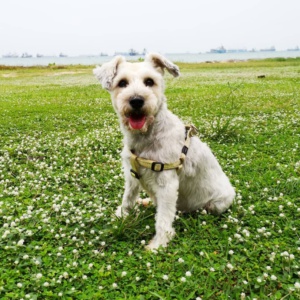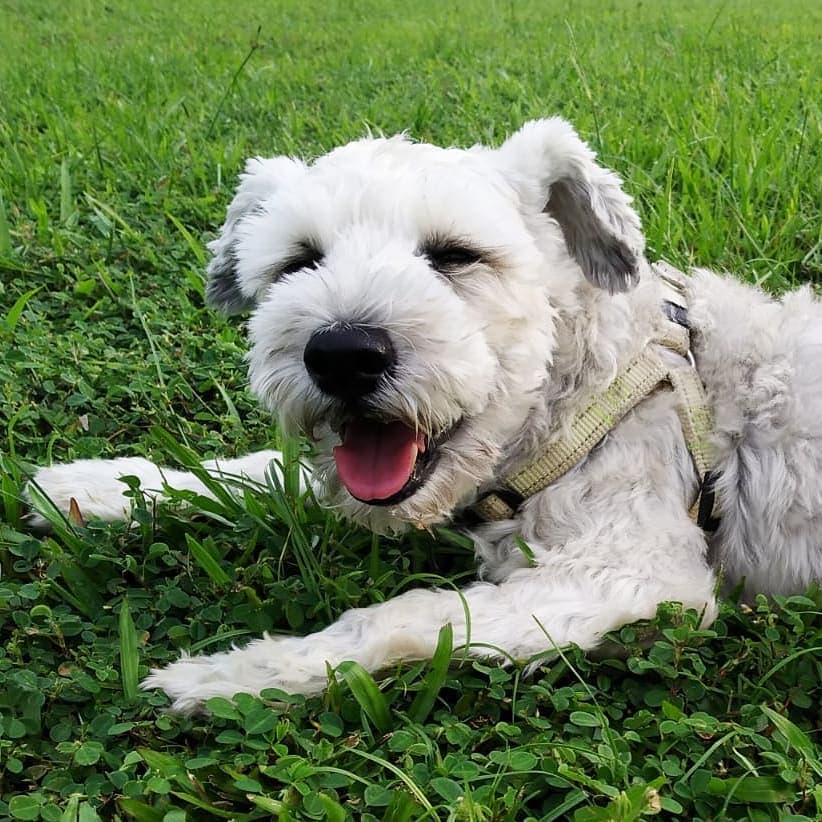Giving belly rubs to our furkids is great fun for the dogs and pawrents. It is a great activity to bond and keep us happy by making our pets happy too. However, frequent belly rubs can do something that is rather crucial and important – detecting abnormal growths. Tumours in dogs, a common occurrence in senior dogs, are 50% malignant and 50% benign. When discovered, especially for pawrents with senior dogs, the common concern was whether it is safe for our dogs to go through with the removal surgery.
While I am neither an expert nor a vet, I will share my experience with tumours on my 13-year-old Miniature Schnauzer, Fifi, from the discovery to the removal process.
The Backstory

Fifi has been loved by my family since she was 2 months old. We never spayed her since young as my dad wanted to let her be natural, but that became a constant dilemma within me throughout the years. With every vet visit, the vet will always remind us how important it is to get her spayed as it will pose serious health issues to her as she ages. Finally, my dad agreed to spay her upon hearing about laparoscopic spay which would be less invasive and harmful to Fifi. She was neutered at Animal Recovery Veterinary Centre last year in April. We were extremely happy with how the vet handled her spay as there was a complication that occurred. Fifi’s ovaries did not stop bleeding from the laparoscopic spay thus they had to operate her to remove them, turning the procedure into a full spay.
Discovering the tumours
We discovered a tumour before the spay. One day, while I was rubbing the belly of Fifi, I noticed a hard lump in one of her mammary glands. It was small and invisible to the naked eye. Thinking that it was just a cyst that might go away, we paid not much attention to it. However, knowing that it wasn’t normal, we brought it up to the surgeon who is in charged of her spay. The vet said that we should monitor the mass and it would be best to remove it especially if it grows. No vets will be able to advise if the mass is malignant or benign before removal. Seeing that the tumor did not grow, we left it alone while we tried to save up for her surgery since we did not know about pet insurance in her younger years.
Decision to remove
Noticing that the tumour grew, we started considering removal surgery for her. Like any pawrents, I want to give my furkid the best life ever. However, considering her age, it was not an easy decision to make since the risk of surgery increases with age. I spoke to some friends who are dog owners, googled for articles and discussions about senior dogs undergoing surgeries and spoke to the vets we visited. Some form of assurance was offered when the information I gathered were success stories of senior dog surgery even though some of my friends advised that we should just let her enjoy her golden years.
In the end, I just couldn’t imagine myself putting her through the pain and suffering she might face from cancer since it is inevitable that malignant tumours will definitely develop into an emergency situation. We chose Animal Recovery Veterinary Centre to carry out her surgeries again since her previous surgery record is with them and we thought that the vets might be more familiar how to proceed knowing her surgical history. Animal tumours from other vets in Singapore will also be sent to them for biopsy since only they have the facilities to carry out the test. The vet in charge was Dr. Wong Hoong Kien. While I was still not fully confident of our decision even during the pre-surgery consultation, there was a dog which came in as an emergency case of tumour and that incident then confirmed that we made the right choice.
During the consultation, we were rather shocked to learn that Fifi actually has 6 mammary tumours with 4 being really small and hard to detect. The vet then said that we had to remove them with two surgeries or the wound would be too large to heal. The first surgery will remove 3 tumours on the right and the second will remove the remaining tumours on the left. Dr. Wong was very patient in explaining to us the process of the surgery and that comforted me that Fifi will be in good hands.
My surgery procedures experience

On the night before the surgery, Fifi had to fast from 12am with no food or drinks. As with all surgeries, Dr. Wong ran a blood test to make sure that Fifi is healthy enough to undergo the surgery. Usually, the blood test and the surgery is carried out on the same day hence, we were instructed to drop her off at 9.30am to allow enough time for both procedures. However, Fifi’s white blood cell (WBC) count was marginally low. Since there could be multiple reasons for this, Dr. Wong suggested us to do additional tests (X-Ray and Ultrasound) just for a peace of mind instead of rushing for removal, to make sure that there is nothing critical that might be causing the low WBC count. Both test turned out normal and with that, Fifi was booked for the surgery on another day.
We dropped her off at 9.30am on the actual surgery day with Fifi fasted. We then had to sign a form for permission to resuscitate Fifi should her heart stop in operation. The initial deposit was SGD1500 and Dr Wong ran the blood test again just to check if the WBC might have increased. Even though there was only a slight increase, he said it should be enough for her to fight off the infections. Usually, the centre would call me between 11am to 2pm to inform me about the test results and that they will proceed with the surgery.
For most dogs, it should be a day surgery procedure. However, due to her age and in consideration of the low WBC count, Fifi was hospitalised just to make sure that she is in good care for her initial healing. We could send food to her and were allowed to visit her between 5pm to 7pm. Dr Wong and the nurses who helped did a great job with Fifi. She was fine when we visited her and was standing up in her ward. We were relieved to see her being able to stand and even greet us with her adorable face. My stubborn baby who is extremely attached to us refused to eat because she misses us, thus we were advised to keep her in the centre for 1 more day just in case she is not eating due to pain. The next day, she ate when we fed her our home cooked food so she was discharged the following day.
Post surgery experience

Fifi was emotional when she reached home. We had to cage her up for her own good so that she does not move around too much as she is rather hyperactive for her age. On the first day home, Fifi would whimper throughout the whole day and she did it even more when one of us leave the house. She had bandages on the would so We did not have to worry about her licking her wound initially. However, she had to wear the Cone of Shame since she starts licking her wound as soon as the bandages come off. Caring for her was not difficult as we learnt how to carry her without hurting her wound as well as how to trick her to eat her medicine by mixing her food.
Dr. Wong would also call to check in a week after the surgery just to get updates from us to make sure Fifi is okay. He also asked me to send him pictures of her wound so that he can assess the recovery. There was a mild infection on her wound so we went to the vet to pick up some antibiotics for Fifi. She recovered soon after finishing her dosage. There will be a post-surgery follow up consultation which the vet will update us about the biopsy results of the tumours as well as advising us on the next step. For the first surgery, Fifi had 1 malignant tumour and 2 benign. Thankfully, Dr Wong was wise to cut slightly wider and deeper to make sure he completely removed the tumour cells to reduce the chance of regrowth. However, it is advisable to send her for check ups every 3-6 months just to make sure there are no regrowth.
4 weeks after her first surgery, Fifi went through the same procedures for the remaining tumours smoothly. She is recovering right now from her wound and we are pleased to learn that all the remaining tumours removed are benign. With this removal, I hope that Fifi can stay with us for many more years into her ripe old age.
A note to pawrents
While this article is not meant to serve as an advise on whether your senior dog should undergo surgeries, Fifi’s example (as with many other stories out there) is meant to bring hope for you that surgery might still be an option. Ultimately, it really depends on you to choose with consideration of your pet’s health status, the severity of the condition and the how invasive will the procedure be. Do not be afraid to take a chance and give your pet a fighting chance against tumours just because of age factor.
To summarise, the following factors should be taken into consideration when you are deciding on whether to pursue surgery:
- Pet’s health (age, healthiness, strength etc.)
- Condition’s severity
- Procedure’s risk and side effect (if any)
- Experience of surgeons and clinic
- Price
- Facilities of clinic (ward, surgical equiments, testing facilities)
- Reviews of vet and clinic (from fellow pawrents and community)
- Research your vet (some of them have LinkedIn with their background)
P.S. My family sincerely thank Dr. Wong and the nurses involved in Fifi’s time with them for the excellent care she received and going the extra mile to make sure that she’s doing okay even after her surgery. While she gave them a hard time for not eating, the nurses were patient enough to handfeed her and I am touched by the gentle treatment they gave her. The team has put in great efforts to comfort her of her anxiety and stress. My family will always be grateful.
The above article is written by the hooman of @fifi.prinsassy.
* This blog is designed to be a community where pet owners can learn and share. The views expressed in each post are the opinion of the author and not necessarily endorsed by Pawjourr. Always consult your veterinarian for professional advice.
